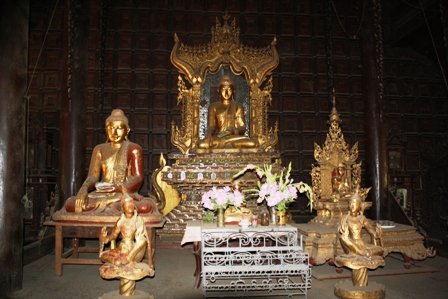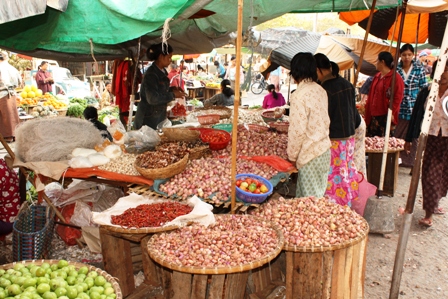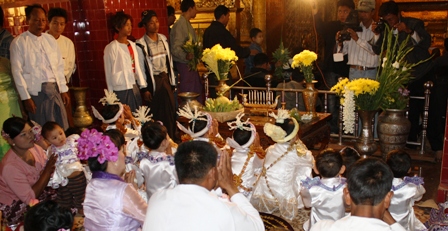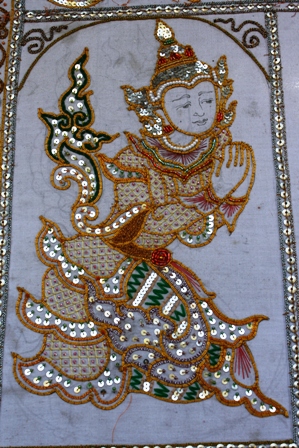
Click the photo above to see an album of photos. To return to our website close the window.
Read previous March of the Monks or next Ancient Cities
Saturday 9 January 2010 Mandalay
The long ridges of hills in Myanmar are clearly visible from the small twin engine plane flying us from Heho, the airport for Inle Lake, to Mandalay. There are few towns and even fewer roads over the hills, just the perfect area to explore by foot, but that must wait for another visit.
The new airport is situated an ungodly 45 Km out of Mandalay. It was built anticipating lots of international traffic but so far you can fly form one southern town in China or Chaing Mai in Thailand to Mandalay, but not the other way around. We are the only plane on the runway and the only people inside waiting for our luggage. The same plane flew us to Heho from Yangon and the luggage was delivered to the arrivals lounge directly from the plane. It was very efficient. In Mandalay we must wait for the luggage to be off loaded from the plane and put on the modern conveyor belt system. It is all spanking new but much slower.
We finally collected our luggage and shared an old taxi, the only king available in Myanmar, with some locals. The taxi driver, a young man, had a big wad of Betel juice in his mouth. It is like chewing tobacco except that it turns your teeth red and we suspect, decays the teeth. It is very popular, especially with the men, judging from the number of red mouths we have seen. Our driver spit a long stream of red out of the car window every few minutes. I was surprised there was not a long red streak down the driver side door. He was a safe driver and we arrived safely at the Guesthouse of our choice, only to be told they were full.
The high season has started in Myanmar and we cannot always arrive without a reservation. We took a room in another small hotel half a block away but it was small and on the sixth floor with no elevator. We decided to upgrade from $12 to $22 per night, and reserved a much nicer room at the Royal City Hotel not too far away.
We booked a trishaw driver, Toke, for a tour the next day of the city. He offers to move us to the Royal City and arrived the next morning with another trishaw driver to move the two of us. A trishaw is a bicycle attached to a side car with two back to back seats. For the move we sat facing forward and our luggage was strapped behind us. Trishaws are not allowed to travel on the busiest streets during the day. This is fine with me as the traffic can be heavy and there are almost no traffic lights. A policeman directed traffic at the busiest corner but that was an exception. I closed my eyes at several intersections but our driver knew what he was doing and we never had a problem.

The faithful love to prove their devotion by buying and applying very thin pieces of gold on their favourite Buddha or stupa. We visited the shop that makes the gold leaf. A one carat block of 24 carat gold is processed by hand to produce hundreds of tiny pieces of gold leaf. The original block is placed between sheets of paper inside a thick covering of leather and pounded with a heavy wooden mallet until it is flat. This operation was performed by men with big arm muscles for ½ to one hour at a time. The pounding must be repeated many times until the gold is small enough to be cut and packaged. Women sat in a separate room and painstakingly cut the thin gold pieces into saleable size. When the pieces were small enough, wafer thin squares are placed between sheets of paper and 20 or more are tied together in a stack. Our guide applied two small pieces on the back of our hand and told us we could eat it as it is said to be good for your health. It didn't have any taste as far as I was concerned.

A woman sat just inside the gates leading to the main temple area with two upside-down bamboo baskets containing sparrows and blackbirds. For a donation of a few 1000 K you get to release one of the birds to the wild. On another occasion we saw baby owls being held hostage in the same sort of cage. I hated the thought of perpetuating this practice by paying their captors money to release birds that should not have been caught in the first place.
Shwe In Bin Kyaung, a teak monastery, was built in 1895 by wealthy Chinese Jade merchants. Traditionally monasteries were built of wood but not many remain. They fell prey to the elements or were destroyed by fire. This one and another, Shwenandaw Kyaung, remain in Mandalay. Shwenandaw was originally inside the Royal Palace walls but was dismantled and reassembled at its current location near the Palace compound. WWII bombs destroyed all the building inside the palace walls but the monastery survived.
Two pagodas stand across from each other near the Shwenandaw monastery. Sandamuni is surrounded by 1,774 small stupas each containing a marble stele inscribed with pages from the sacred Triptaka books. The other continues the theme inside interconnected stupas containing 729 marble slabs with commentaries on the Triptaka. The faithful still visit all the temples and offer prayers and gifts for their safekeeping.

Our day ended without the popular sunset visit to Mandalay Hill or a visit to the Royal Palace. We had enjoyed our day but any more and we would lose track of what we had seen.